|
  |
|
Page 2 |
Newsletter 117, Summer 2017 © Hampshire Mills
Group |
Mills over the border – Mills in Sussex
Peter
Hill’s talk to the Hampshire Mills Group, as reported by Alison Stott
Updated
with corrections from Peter Hill Oct 2017
Pictures to illustrate the report by Ruth Andrews
and Peter Hill
|
|
Peter
began chronologically with grain being crushed using
the mortar and pestle, saddle quern, and then the
familiar rotary stone quern. As populations
increased animal power was used; Peter had an
interesting picture of an ‘oblique’ ox mill.
About 85BC the little
Norse or Greek horizontal mills appeared with their
small single wheel driving a stone above. Between
20–11BC the vertical waterwheel was illustrated by
Vitruvius in his detailed drawing. 650 years later
the Persian vertical wind tunnels were built,
funnelling the prevailing wind through vertical gaps
in a surrounding wall to turn the blades inside.
|
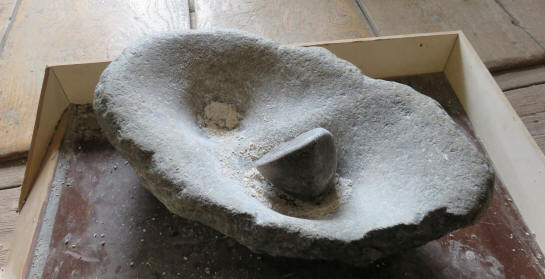 |
|
Peter moved on to
mills in Sussex, illustrating with a map the 80
mills which still exist (formerly 900) with many
more situated on the Eastern side of the county
which is more windy. His pictures were arranged
chronologically by type.
The simple trestle
post mill, with no storage, such as Nutley Mill,
cannot be very high, 66ft being the maximum
possible.
|
|
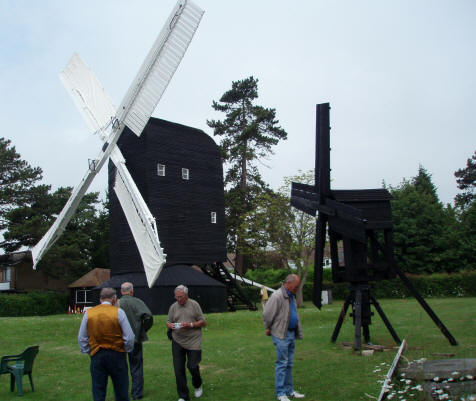
|
High Salvington (left)
is also a post mill, but this time the trestles are
encased in a roundhouse meaning that there is
storage on the site and production can be
increased. Next to it is the windpump from Glynde,
a much smaller hollow post mill.
Peter had a wonderful
illustration of a little post mill being moved from
its original home in Brighton, where it had become
surrounded by new buildings. It was being pulled to
its new home by no less than 82 oxen. (See cover
picture.) Apparently oxen will plod straight and
steadily once set in motion. Another mill was not
so fortunate: it started its journey being pulled
by two teams of 20 horses, but on reaching a corner
one team bolted left and one team bolted right! It
spent a night leaning against a pub before
continuing its journey being pulled by a traction
engine. |
|
On Windmill Hill,
Herstmonceux the mill
(right) has been restored; it is mounted on a
double-storey roundhouse. Peter said that the
miller and the local farmer had a dispute, the
farmer planted trees all around the mill to keep
off the wind, so the miller raised the mill by an
extra storey.
The trouble with
simple post mills was that they had to be turned
into the wind by the miller; this problem was
overcome by the invention of the fantail in 1745.
Originally the fantail was mounted at the end of the
post which was used for turning the mill, the post
being driven round by the fantail to keep the mill’s
sails always facing into the wind.
A couple more mills
which were moved were Jill Mill built in 1821 and
moved to Clayton Hill in 1852 to join a postmill
known as Duncton Gate mill and after the latter was
demolished Jack tower mill was built, in 1866. Lowfield Heath Mill
was moved from
Gatwick, dismantled, and rebuilt in 1987 at Charlwood. |
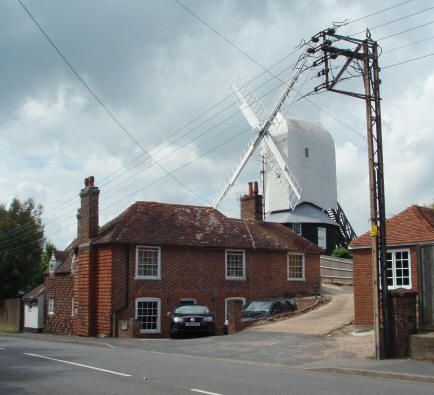 |
|
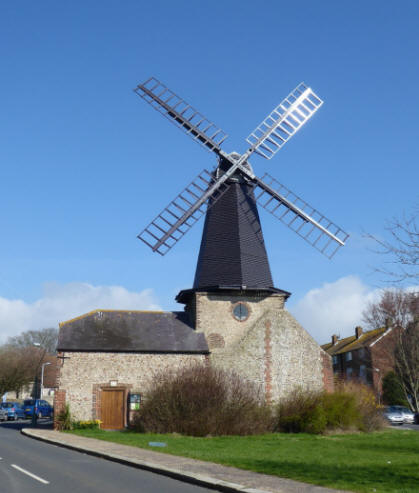
|
The smock mill has a
‘roundel’ base, a reefing stage for setting the
sails, and a cap turned by a tailpole or a fantail.
The shape was said to resemble the smock worn by
peasants at the time, and was usually eight-sided.
Peter showed various examples of this type of mill,
such as West Blatchington (left, which was painted
by Constable, but has six sides rather than the
conventional eight) and mentioned that all the mills
visible from the sea appeared on Admiralty charts to
aid navigation.
The
tower mill, built of brick or stone, could be built
much higher, with a cap driven by a fantail. Being
more substantial, many have survived although
converted to new uses, such as at Battle where the
dust floor is a cocktail lounge. Other mills
converted include Icklesham (post mill) where
Paul McCartney has incorporated a recording studio,
Rye (smock mill) where the mill burned down in 1939 and has been
covered in fibreglass , and Jack which has a chapel
on the stone floor. This is reputedly haunted as
the open pages in the bible on display are
mysteriously turned over! Selsey tower mill
after it ceased work had a new cap fitted and fixed
in position, with a window replacing the fan stage
so that the then owner could enjoy watching the
shipping in the English Channel.
|
|
The most common re-use
is as a house. At Pratts Mill in Crowborough
the tower has been incorporated into the house. The owner of Barnham Mill made great efforts to save it in
working order, but it was for sale in 2015 as a
house.
Peter had many other
pictures of mills, derelict in some cases,
undergoing restoration in others. He had a couple
of examples of mills used for pumping, one which was
near Pevensey can now be seen at the Weald and
Downland Museum where it has been reconstructed but
is not actually working.
His talk ended with a
brief selection of watermills. As he said “so that
we poor windmill-deprived folk of Hampshire would
not feel that Sussex was totally lacking such gems”.
Altogether this was a fascinating tour through our
neighbouring county.
|
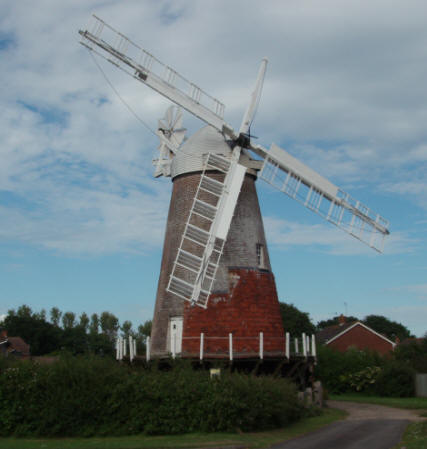
Polegate Mill, restored in 1967 |
| |
|
  |
|
|
